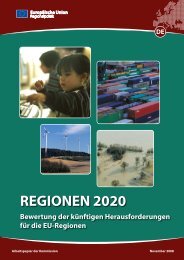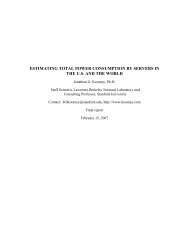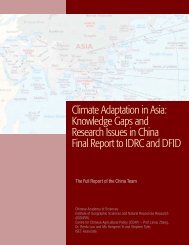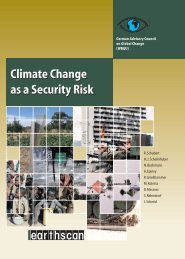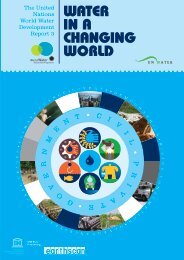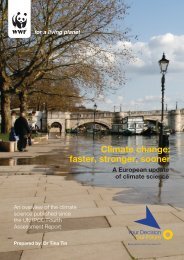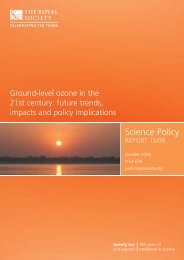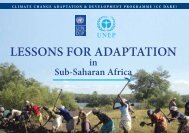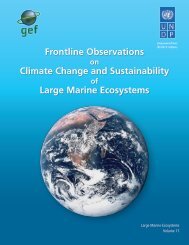Physiological stresses on reef organisms are additive.Although reef <strong>change</strong>s are triggered by elevated temperature,several other factors compound the negativeeffects upon the ecosystems. Pollution from industrial,agricultural, petrochemical <strong>and</strong> domestic sources, sedimentationfrom shoreline erosion, daytime penetrationof intense ultraviolet radiation, <strong>and</strong> hyposalinity fromfreshwater runoff during times of extreme rainfallimpose added environmental stresses that impederecovery of the compromised reef.Caribbean reefs are now subject to annual episodesof bleaching <strong>and</strong> persistent expression of diseases (seefigure 2.31). The imminent collapse of Jamaica’s reefs<strong>and</strong> their overgrowth of macroalgae was alreadyapparent by 1991 (Goreau 1992) as a result ofbleaching stress (Goreau <strong>and</strong> Hayes 2004), massmortality of sea urchins (Lessios 1984), overharvestingof reef fishes (Jackson et al. 2001), <strong>and</strong> excess nutrient-loadingwith nitrates <strong>and</strong> phosphates released fromthe l<strong>and</strong> sources (Hughes et al. 2003).The collapse of reefs means the loss of net benefits thatvary in <strong>economic</strong> value depending upon the degree ofcoastal development. However, in Southeast Asia thetotal loss is estimated to represent an annual value ofUS $20,000-151,000 per square kilometer of reef(Burke 2002). This estimate is based upon an assessmentof benefits derived from fisheries, coastal protection,tourism <strong>and</strong> biodiversity.CORAL DISEASESIn addition, all species of keystone reef-building coralshave suffered mounting rates of mortality from anincreasing assortment of poorly defined emerging bacterialdiseases. Within the last three decades, coralcolonies have become hosts to various microbes <strong>and</strong>have demonstrated limited capacity to either resistmicrobial colonization <strong>and</strong> invasion or defend againsttissue infection <strong>and</strong> premature death (Harvell et al.1999; Sutherl<strong>and</strong> et al. 2004).Bacteria normally live in dynamic equilibrium within thesurface mucous layer secreted by corals. This relationshipbetween bacteria <strong>and</strong> coral mucus is one of mutualbenefit, since tropical waters are nutrient poor <strong>and</strong>incapable of sustaining bacterial metabolism. Coralmucus serves as a source of nutrition for these bacteria,<strong>and</strong> the bacteria, in turn, provide protection tocorals from predators. However, once bacteria colo-nize, invade <strong>and</strong> infect the coral tissue, that relationshipof mutualism shifts to parasitism. The corals, lackingother effective defense mechanisms against infection,are rapidly overgrown by macroalgae, as wellas bacteria <strong>and</strong> other microbes.The most prevalent signs of infection are discoloration,detachment from the skeleton, <strong>and</strong> loss of tissue integrity.Discolorations may be due to bacterial growth (forexample, black b<strong>and</strong>), loss of algae (for example,bleaching, coral pox), or local accumulation of pigment(for example, yellow b<strong>and</strong>, dark spot).Detachment of tissue from the skeleton represents dissolutionof anchoring filaments <strong>and</strong>/or solubilization ofthe aragonitic (a calcium compound) skeleton itself (forexample, coral plague). Tissue necrosis is slowly progressive<strong>and</strong> usually includes a patterned loss ofepithelial integrity (for example, white b<strong>and</strong>).HEALTH AND ECOLOGICAL IMPACTSDecline in the <strong>health</strong> <strong>and</strong> integrity of coral reefs hasmultiple implications for sea life <strong>and</strong> for the coastalzone bordering low-lying tropical l<strong>and</strong>s. Declines <strong>and</strong>loss will decrease their function as nurseries for shellfish<strong>and</strong> finfish (approximately 40% of stocks worldwide),<strong>and</strong> affect the lives <strong>and</strong> livelihoods for communitiesthat depend on fishing for consumption <strong>and</strong> commercialization.The disruption of reefs as shoreline barriersallows salt water intrusion <strong>and</strong> salinization of groundwater.This can lead to hypertension in humans <strong>and</strong>decreased soil fertility for agricultural production (furtheraffecting <strong>health</strong> <strong>and</strong> nutrition). Reefs are alsobecoming reservoirs for microbial pathogens that cancontaminate the food chain, <strong>and</strong> are associated withhuman <strong>health</strong> risks from direct contact with microbeladencoastal waters (Epstein et al. 1993; Hayes <strong>and</strong>Goreau 1998).79 | NATURAL AND MANAGED SYSTEMSCASE STUDIES
HARMFUL ALGALBLOOMSFigure 2.32 Red Tidein suppressing the immune systems <strong>and</strong> thus increasingsusceptibility to infections <strong>and</strong> cancers needs furtherstudy.Brown tides cause hypoxia <strong>and</strong> anoxia, <strong>and</strong> are contributingto the over 150 “dead zones” being reportedin bays <strong>and</strong> estuaries around the world (Rupp <strong>and</strong>White 2003 UNEP 2005), as well as losses of seagrassbeds, nurseries for shellfish (Harvell et al. 1999).Mangroves — whose dropped leaves feed fish <strong>and</strong>whose roots hide them — are being removed foraquaculture <strong>and</strong> coastal development. Mangroves arealso threatened by sea level rise. Loss of wetl<strong>and</strong>s <strong>and</strong>coral reefs, sea level rise <strong>and</strong> greater storm surgesthreaten beaches, roads, homes, hotels, isl<strong>and</strong> freshwater”lenses,” nutrition <strong>and</strong> livelihoods.80 | NATURAL AND MANAGED SYSTEMSImage: P.J.S. Franks/Scripps Institution of OceanographyMarine red tides or harmful algal blooms (HABs) areincreasing in frequency, intensity <strong>and</strong> duration worldwide,<strong>and</strong> novel toxic organisms are appearing(Harvell et al. 1999). Cholera <strong>and</strong> other bacteriaharmful to humans are harbored in the phyto- <strong>and</strong> zooplanktonthat form the basis of the marine food web.The increase in nitrogenous wastes (fertilizers, sewage<strong>and</strong> aerosolized nitrogen) provides the substrate forHABs, while warm, stagnant waters <strong>and</strong> runoff of nutrients,microorganisms <strong>and</strong> toxic chemicals after floodscan trigger large blooms, sometimes with toxin-producingorganisms (Epstein et al. 1993).Most biological toxins from red tides affect the nervoussystem. The effects range from temporary tingling ofthe lips, to headaches, <strong>change</strong> in consciousness,amnesia <strong>and</strong> paralysis. Repeated exposure could possiblylead to chronic fatigue, <strong>and</strong> the role of biotoxinsThe 2005 HAB outbreak of Alex<strong>and</strong>rium fundyense inNew Engl<strong>and</strong> was associated with heavy rains inMay <strong>and</strong> two nor’easters in June. The nor'easters(spawned by high pressure systems over cool freshNorth Atlantic waters) blew the blooms against thecoast <strong>and</strong> brought cold upwelling water with additionalnutrients. The large 1972 bloom in New Engl<strong>and</strong>of the dinoflagellate, Alex<strong>and</strong>rium tamarense, bearingsaxitoxins causing paralytic shellfish poisoning, firstappeared near the mouth of rivers after a droughtended with a hurricane. The extensive 2005 bloom inthe Northeast — affecting tourism, fisheries, livelihoods,event planners <strong>and</strong> restaurants — cost US $3million a week <strong>and</strong> could seed cysts along manysquare miles of coastline, setting the stage for harmfulalgal blooms in subsequent years.A red tide persisting at least nine months off Florida’swest cost has taken a large toll on fisheries, livelihoods<strong>and</strong> tourism (Goodnough 2005).– P.E.CASE STUDIESECONOMIC DIMENSIONSTable 2.4 provides a global environmental <strong>economic</strong>estimate of the potential new benefit streams fromcoral reefs per year <strong>and</strong> the net present value (NPV) ofthe world’s coral reefs in billions of US dollars. Thisanalysis is based upon a 50-year extrapolation at adiscount rate of 3% (Cesar et al. 2003).Table 2.4 The “Value” of Coral ReefsGOODS / SERVICESFisheriesAMOUNT (in US $BILLION)5.7Coastal Protection 9.0Tourism / Recreation 9.6Aesthetics / Biodiversity 5.5TOTAL 29.8NPV 797.4Source: Cesar et al. 2003
- Page 1 and 2:
Climate Change FuturesHealth, Ecolo
- Page 4 and 5:
Table of ContentsIntroductionPart I
- Page 6 and 7:
EXECUTIVE SUMMARYClimate is the con
- Page 8 and 9:
the past decade, an increasing prop
- Page 10 and 11:
THE CASE STUDIES IN BRIEFInfectious
- Page 12 and 13:
THE INSURER’S OVERVIEW:A UNIQUE P
- Page 14:
Regulators and governments can empl
- Page 17 and 18:
THE PROBLEM:CLIMATE IS CHANGING, FA
- Page 19 and 20:
Figure 1.3 GreenlandEXTREMESOne of
- Page 21 and 22:
20 | THE CLIMATE CONTEXT TODAYWholl
- Page 23 and 24:
Figure 1.5 Global Weather-Related L
- Page 25 and 26:
Climate signals in rising costs fro
- Page 27 and 28:
CLIMATE CHANGE CANOCCUR ABRUPTLYPer
- Page 29 and 30: 28 | THE CLIMATE CONTEXT TODAYCCF-I
- Page 31 and 32: communities, salinizing ground wate
- Page 33 and 34: Health is the final common pathway
- Page 35 and 36: 34 | INFECTIOUS AND RESPIRATORY DIS
- Page 37 and 38: Figure 2.4 Malaria and Floods in Mo
- Page 39 and 40: Figure 2.61920-1980CASE STUDIES38 |
- Page 41 and 42: A MALARIA SUCCESSThe New York Times
- Page 43 and 44: A new flavivirus, Usutu, akin to WN
- Page 45 and 46: 44 | INFECTIOUS AND RESPIRATORY DIS
- Page 47 and 48: One analysis (Vanderhoof and Vander
- Page 49 and 50: BIODIVERSITYBUFFERS AGAINSTTHE SPRE
- Page 51 and 52: Figure 2.15 RagweedMOLDSLong-term f
- Page 53 and 54: ASTHMA COSTSTODAYexamples, the Afri
- Page 55 and 56: Stott et al. (2004) calculate that
- Page 57 and 58: In the summer of 2005, northern Spa
- Page 59 and 60: a better understanding of subpopula
- Page 61 and 62: 60 | EXTREME WEATHER EVENTSFLOODSFO
- Page 63 and 64: MOSQUITO- AND SOIL-BORNE DISEASESEC
- Page 65 and 66: Table 2.2 Direct and Indirect Healt
- Page 67 and 68: HEALTH AND ECOLOGICALIMPLICATIONSOu
- Page 69 and 70: 68 | NATURAL AND MANAGED SYSTEMSCAS
- Page 71 and 72: Figure 2.27 Soybean Sudden Death Sy
- Page 73 and 74: 72 | NATURAL AND MANAGED SYSTEMSCAS
- Page 75 and 76: 74 | NATURAL AND MANAGED SYSTEMSCAS
- Page 77 and 78: 76 | NATURAL AND MANAGED SYSTEMSCAS
- Page 79: 78 | NATURAL AND MANAGED SYSTEMSTHE
- Page 83 and 84: 82 | NATURAL AND MANAGED SYSTEMSCAS
- Page 85 and 86: CASE STUDIES 84 | NATURAL AND MANAG
- Page 87 and 88: CASE STUDIES 86 | NATURAL AND MANAG
- Page 89 and 90: CASE STUDIES 88 | NATURAL AND MANAG
- Page 91 and 92: CASE STUDIES 90 | NATURAL AND MANAG
- Page 93 and 94: “Climate change is one of the wor
- Page 95 and 96: 94 | FINANCIAL IMPLICATIONS• Incr
- Page 97 and 98: Extreme weather events are a partic
- Page 99 and 100: 98 | FINANCIAL IMPLICATIONSTable 3.
- Page 101 and 102: 100 | FINANCIAL IMPLICATIONSdemand
- Page 103 and 104: 102 | FINANCIAL IMPLICATIONSClimate
- Page 105 and 106: These include:Solar Photovoltaic Pa
- Page 107 and 108: • Social and economic factors in
- Page 109 and 110: Finally, new technologies need to b
- Page 111 and 112: 110 | FINANCIAL IMPLICATIONSBRETTON
- Page 113: 112 | APPENDICESAppendix A. Summary
- Page 116 and 117: Table B.1 Summer Percentage Frequen
- Page 118 and 119: Climate sensitivity for small-scale
- Page 120 and 121: diffuse and do not manifest in sing
- Page 122 and 123: APPENDIX D.LIST OF PARTICIPANTS ATT
- Page 124: Carmenza RobledoGruppe OekologieEMP
- Page 127 and 128: 126 | BIBLIOGRAPHYBibliographyAAAAI
- Page 129 and 130: 128 | BIBLIOGRAPHYChordas, L. Epide
- Page 131 and 132:
Ford, S.E. & Tripp, M.R. Diseases a
- Page 133 and 134:
132 | BIBLIOGRAPHYKalkstein, L. S.,
- Page 135 and 136:
134 | BIBLIOGRAPHYMills, E. The ins
- Page 137 and 138:
136 | BIBLIOGRAPHYRose, J. B., Epst
- Page 139 and 140:
138 | BIBLIOGRAPHYVandyk, J. K., Ba
- Page 142:
Infectious and Respiratory Diseases



